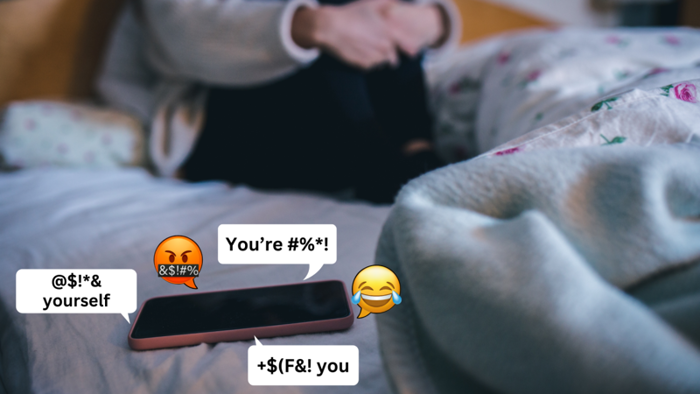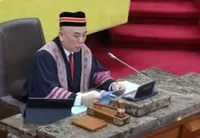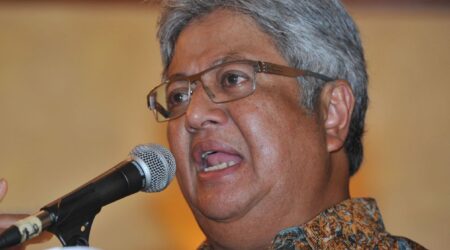‘They said they were going to kill me’
PETALING JAYA: Ming (not her real name) was 18 when she met her harasser via online gaming.
“(In 2018) I was very isolated and spent all of my time online. I had very low self-esteem,” said the now 24-year-old, adding that this man she met online made her “feel desirable for the first time”.
Ming and her “friend” grew very close, and she would often send him photos of herself and her daily life.
Eventually, however, the messages became sexual in nature.
“He started telling me that he would pleasure himself to my pictures and would send explicit photos (in return),” she said.
At one point, the man told Ming that he wanted to “put a collar on her” and requested that she use sex toys.
“When it got to that point, I slowly started distancing myself,” she said.
Still, Ming, who asked to remain anonymous, felt as though she could not speak up as a victim because she felt that she was to blame for enabling such behaviour in the first place by sending the man her photos.
“I would try to ignore him but I couldn’t bring myself to block him.
“Sometimes, I would feel so scared and sad that I would text him and apologise”, she said.
The man would get angry if she did not reply to him within the day. Soon, the angry texts escalated into calls.
“Once, I picked up (one of his) calls and he called me expletives. He said this was why everyone hated me and that I should be glad for the attention he was giving.”
Recalling that her abuser had her address and knew what she looked like, Ming became so stressed that she was regularly throwing up and losing a significant amount of weight.
Ming’s case is one of a personal victim-bully relationship.
While bullying existed long before the internet, the rise of the digital age has introduced a more pervasive and relentless form of such behaviour, and provided a public arena for it to fester.
Digital spaces enable and encourage people to conceal themselves behind a mask of anonymity, creating the perfect environment for a new breed of bullies – cyberbullies.
Unlike traditional bullying, cyberharassment transcends physical bounds.
Where bullying was previously limited by proximity and ease of access, cyberbullying has unlimited reach. This relentless, and often hidden form of abuse, creates a unique set of challenges for individuals, particularly digital natives, who may find themselves facing a constant barrage of online torment.
<esha’s here=”” mugshot=””>
The tragic suicide of social media influencer A. Rajeswary, better known as Esha, following prolonged harassment on social media platform TikTok has thrust this insidious threat into the limelight.
However, Esha’s case is by no means an isolated incident.
In fact, the Malaysian Communications and Multimedia Commission (MCMC) reported that it received 3,199 complaints related to cyberbullying in 2023, and the number of unheard victims could be substantially higher.
According to Kavilan Gukacumaran, a registered counsellor with mental health centre Next Chapter, social media is enabling those who may already have the tendency to become bullies but were too afraid in the past to act on such urges in real life.
“The cyberspace removes these inhibitions,” explained Kavilan.
‘Laws unable to keep up’
According to Asst Prof Dr Mastura Rosly from the Faculty of Psychology and Social Sciences, University of Cyberjaya, a survey on civility, safety and interaction online released in conjunction with this year’s Safer Internet Day showed a jump in the number of teens (60%) talking to someone about being harassed or feeling at risk.
While Malaysia was not among the 17 nations included in the survey, a separate World Health Organisation (WHO)study spanning 44 countries corroborated these findings, stating that 16% of children aged 11 to 15 reported being cyberbullied in 2022, an increase from 13% in 2018.
This experience is not unique to teens as US think tank Pew Research Centre’s study from 2021 found that over 40% of adults have also experienced some form of cyberbullying or harassment online.
These numbers could be even higher as experts acknowledge that it is hard to accurately define cyberbullying, and thus study its incidence rates.
Such trends are evolving so fast that lawmakers and authorities are finding current laws too outdated to tackle the unique and ever-changing aspects of cyberbullying.
Digital Safety Tips by The Star
In Malaysia, such cases currently fall under the Communications and Multimedia Act 1998, which, on its own, has proven inadequate to punish digital bullies.
On July 24, Digital Minister Gobind Singh Deo announced that several amendments, including legislative measures, to address cyberbullying are in the works.
According to the Digital Minister, a special committee including the Communications Ministry, the Home Ministry, the Digital Ministry, and the Legal Affairs Division of the Prime Minister’s Department (Law and Institutional Reform) has been formed to thoroughly review the Penal Code to combat cyberbullying, with amendments expected to be tabled in Parliament this October.
“Of late, Malaysia has made significant reforms in legislation with significant trickle-down effects both directly and indirectly for better mental health, such as the decriminalisation of suicide and criminalisation of stalking.
“There has been a public outcry for clearer definitions and heftier repercussions to cyberbullying, reflecting a society that is aware of and shuns bullying.”
“However, punitive measures alone may not be adequate. Focus should also be given to reforming behaviour and having correctional programmes for perpetrators,” said Dr Mastura.
‘A spotlight on victims’
From the perspective of a counsellor, Kavilan explained that everyone has their “breaking point”.
Individuals who are not emotionally prepared or resilient enough to handle the abuse hurled at them online are more likely to reach this breaking point more easily, he pointed out.
Once this happens, even minor things can become a trigger.
“Victims of intense cyberbullying commonly develop depression markers, stop doing the things they love to do and lose faith in themselves and humanity,” said Kavilan.
Those who are already in a vulnerable situation, such as individuals who lack a proper support system, are also more susceptible to being pushed to the edge by cyberbullies, he added.
Local model and actress, Joanna Joseph, 27, shared her experiences when her compromising photos got leaked online when she was a teenager.
She recalls how the traumatic experience, which happened when she was 14, put her in a vulnerable and scary position.
“People would make fake accounts using my photos for their profile picture and the photos spread like nobody’s business so that many people were getting them,” she said.
But the harassment did not end in school.
When she was older, Joanna experienced another wave of cyberbullying via anonymous Q&A ‘question box’ platforms like ASKfm and NGL.
“I received horrifying messages from people saying they were going to kill me and that they wished I was dead. Some even told me to commit suicide,” she said.
Joanna said the scariest part about these messages was that they could be from anyone, including her own friends.
The final blow landed some five years ago.
A music video she starred in was picked apart by troll pages and reposted on Facebook with nasty captions and headlines such as ‘Fat girl loses weight to become porn star.’
With some of the posts being shared between 10,000 to 15,000 times, and receiving around 6,000 comments, they even mentioned where she stayed, which university she went to and even her phone number.
Although Joanna said she lodged police reports and reporting to MCMC, there had so far been no progress in her case.
In Esha’s case, two people have been charged with communication offences on TikTok.
One of them, lorry driver B.Sathiskumar, was charged under Section 233(1)(a) of the Communications and Multimedia Act with posting lewd comments on TikTok and faces a fine of up to RM50,000, imprisonment of up to one year, or both, with an additional fine of RM1,000 for each day the offence continues after conviction.
Sathiskumar also faces a second charge under Section 509 of the Penal Code, which he claimed trial to.
Meanwhile, Shalini Periasamy, the owner of a private psychiatric care nursing home, pleaded guilty to deliberately uttering vulgarities with the intention to incite anger and disturb peace through her TikTok account.
She was charged under Section 14 of the Minor Offences Act, which provides a maximum fine of RM100.
Joanna said people should talk more about the consequences that these types of harassment have on the mind, and the trauma that people go through.
“There should be more mental health workshops, more campaigns in school and more transparency about what bullying or cyberbullying can lead to,” she added.
For those interested in being a content creator or an influencer, Joanna said: “If you’re not ready to deal with the crazy side of the net, don’t do it. It’s really not worth it.”
Influencer Arwind Kumar, 29, describes social media as “an ocean where sharks swim” and warns that those who intend to use these platforms, especially to make a living, must be aware of the ugliness that comes along with it.
While social media platforms such as Facebook, Instagram, X and TikTok have Safety and Community Guidelines, users are not forced to follow them.
Enforcement is also lacking and many cases slip through the gaps unless they go viral or involve a user with a significant following.
Arwind said he faces a lot of prejudice online for his personality, the way he carries himself and, occasionally, the topics he chooses to talk about on his platform.
Most of the time, he is unaffected by the abuse hurled at him but even someone as resilient as Arwind has found online bullies to be too much.
He recounts how one of his videos blew up some years back and was heavily criticised.
Some particularly vicious attacks left him wondering what he said or did wrong, especially as they were coming even from people he considered to be his close friends.
In cases like these, Kavilan explained that there is a difference between disagreement and bullying – the former is a way for people to voice differing opinions, whereas the latter is less about “right and wrong” and more about power dynamics and putting the victim down.
“It takes people who display narcissistic personality traits (to bully someone), someone who will assert “I don’t care if you are right or wrong, I am superior,” explained Kavilan.
Arwind, too, withdrew from social media for a few weeks following the backlash against his video, but eventually turned around and accepted this as a life experience he could grow from.
The support he received from his mother and best friend also helped him get through those trying times.
“How long can I hide? (Social media) is my career. I learnt a valuable lesson that not everyone is going to agree with my opinion.”
“However, (even if you do not agree), you cannot force me to do something I don’t agree with,” he said.
Nowadays, Arwind treats such verbal wars and nasty comments as water off his back.
“These sharks continue to live only when fed. We have to stop feeding them the attention they crave. You do you but wisely,” advised Arwind for those dealing with cyberbullies.
What’s next?
So, what steps should victims take and what can the public do to help?
How to deal with Cyberbullies by The Star
Aside from disengaging with bullies, the victims and experts The Star spoke to emphasise the importance of professional help.
“Mental healthcare providers such as psychiatrists, psychologists or counsellors are trained to assess the effects of cyberbullying, which may be present as psychological distress, acute stress, anxiety or depression,”said Dr Mastura.
“Counselling is a space where victims are not judged,” said Kavilan.
In other words, people who are afraid to take off the mask they have been living with in public, especially if this comes as a result of psychological trauma, can be assured of a safe space to be themselves.
Unfortunately, there is still a stigma around seeking mental health services, which leads to many victims choosing to suffer in silence.
“Make mental healthcare accessible and free from judgement. These ideals have been outlined by United Nations’ Sustainable Development Goals. It’s high time that we as a society walk the talk,” said Dr Mastura.
“If you have diabetes, cancer or any other (physical) illness, you know step by step what you need to do and where you need to go but the same cannot be said of mental health support. More work needs to go into dismantling the stigma,” said Kavilan.
Dr Mastura is also of the opinion that schools and workplaces have huge roles in making the world a safer place from cyberbullying, saying that programmes to create awareness about cyberbullying and its effects on mental health are a good place to start.
The renewed interest in cyberbullying following Esha’s case has led to the launch of several such organised campaigns, such as social media personality Jane Teoh’s #DareToShout anti-cyberbullying campaign.
Teoh said her campaign has been progressing positively, gaining attention and engagement from schools and educational institutions.
“My goal is to grow the campaign and enhance its impact on raising awareness and driving change,” she added.
Teoh believes the public plays a crucial role in the success of such initiatives, and urges everyone to actively participate in and promote anti-cyberbullying campaigns.
“By cultivating a positive online environment and supporting campaigns dedicated to tackling cyberbullying, we can collectively work towards reducing its prevalence and creating safer spaces for everyone,” she said.
For every individual who chooses to make their corner of the cyber world a little kinder, the internet becomes a safer place for us all.
If you or someone you know is undergoing psychological distress, do reach out for help at these numbers – Talian Heal 15555, Talian Kasih 15999 or call the Befrienders hotline at 603-76272929 or e-mail [email protected]





















Leave a Reply